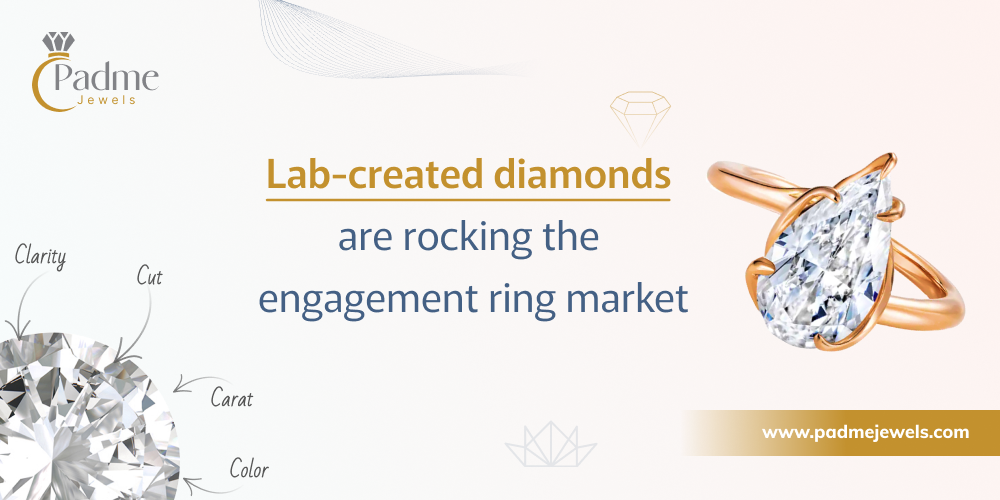Engagement rings
Lab-created diamonds are rocking the engagement ring market
A significant number of engaged couples are opting for engagement rings that feature synthetic rather than naturally occurring gemstones, including the primary diamond.
Check out our blog highlighting the popularity of lab-grown diamonds.
Although diamonds remain the top choice for engagement rings, approximately 25% of these rings in 2021 had a man-made center stone, which could be any type of gem, indicating an 11% increase over the last two years.
Report of Shash Camdaar:
Shash Camdaar, a custom jeweler and graduate gemologist working at “The Exclusive Gem” located in downtown Norfolk, has witnessed significant changes in the diamond growing process over the years.
According to Camdaar, natural diamonds are usually found in coal shafts, where a certain portion of the shaft crystalizes.
He went on to explain that a lab-created diamond is produced by taking a tiny piece of a natural diamond and allowing it to grow over the course of a few weeks.
Report of Kathryn Bonheur:
The present trend is associated with a growing environmental consciousness, particularly among the younger demographic, exemplified by Kathryn Bonheur, a patron of the nearby jewelry store.
Kathryn Bonheur explained that mined diamonds come with a range of ethical considerations, such as exploitation, labor rights, land rights, and the individuals involved in the extraction process.
Despite their physical similarities, natural and lab diamonds possess unique pricing structures.
According to Magana (senior manager of diamond identification for the Gemological Institute of America (GIA), both varieties exhibit the same level of sparkle, fire, and durability, lasting a lifetime.
However, Camdaar noted that lab-grown diamonds typically cost one-third to one-fifth the price of natural diamonds, offering considerable savings to customers.
Industry embraces lab-grown:
The company based in Copenhagen has decided to transition towards producing diamonds created in a laboratory.
As for its jewelry, its “Moments” collections performed well, as did its “Diamonds by Pandora” lab-grown jewelry line, which got its start in the U.K. before launching in North America last year.
Report of Pandora:
Pandora, a jewelry enterprise, declared its decision to exclusively employ sustainable, lab-grown diamonds while discontinuing the use of mined diamonds.
Report of Signet:
Jamie Singleton (president at Signet Jewelers) noted that there are currently three prominent trends governing engagement ring preferences.
These include an inclination towards larger stones with a size range of 1 to 3 carats, a preference for yellow gold, and an interest in unconventional center stone shapes such as ovals, pears, and emeralds.
When purchasing lab-created diamonds, it is important to take into account their resale value, according to Brown.
She explained that compared to natural diamonds, lab-created diamonds are not as profitable of an investment, and consumers may be unaware of this.
Report of Rapaport:
Rapaport, the founder of the Rapaport Diamond Report and the Rapaport Group, concurred with Brown’s assessment, explaining that synthetic diamonds do not possess the natural rarity of mined diamonds, and can be produced limitlessly through the use of machines.
As a result, their resale value is not as substantial as that of natural diamonds.
He also emphasized that marketing man-made diamonds without disclosing this critical piece of information is misleading, even if certain customers may not be concerned with resale value.
CONCLUSION:
In conclusion, it is clear that the popularity of man-made diamonds has been on the rise, particularly among younger consumers who prioritize ethical and sustainable production.
Lab-created diamonds are not just environmentally friendly but also more affordable than their natural counterparts.
However, it is important to consider the resale value of man-made diamonds before making a purchase, as they may not retain their value as well as natural diamonds.
Overall, the trend towards man-made diamonds in the engagement ring market is a reflection of changing values and preferences among consumers.
It will be interesting to see how the industry continues to evolve in response to these shifts.

